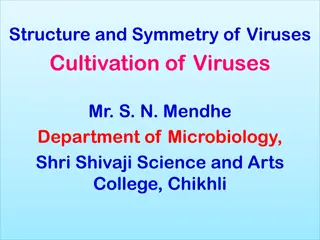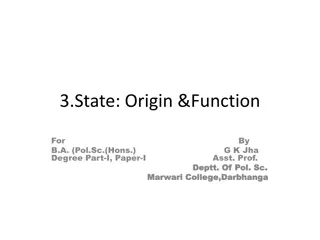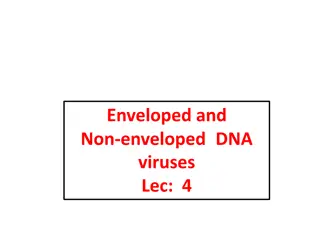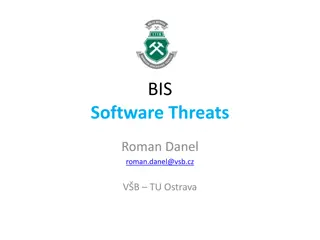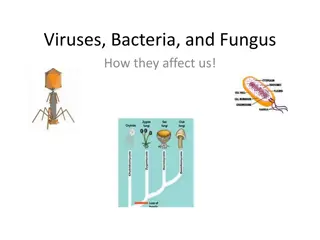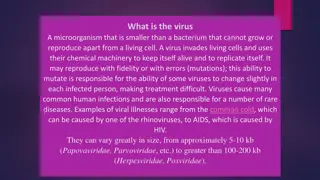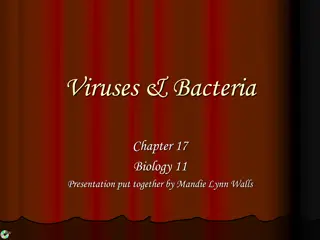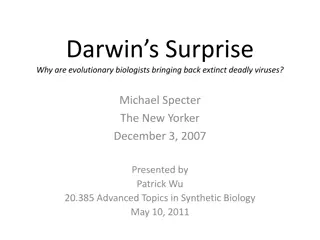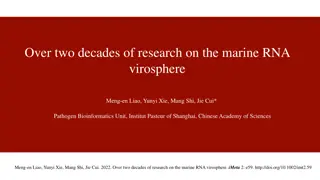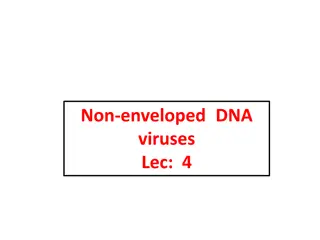The Origin of Viruses: Theories and Evidence
Viruses are acellular parasites with a complex replication mechanism. Studies on their origin present challenges due to the lack of fossils. Three main hypotheses include regressive, cellular origin, and co-evolution. The regressive hypothesis suggests viruses originated from complex ancestors that evolved into obligate intracellular parasites. Evidence supporting regression theory includes the evolution of large DNA viruses like Nucleocytoplasmic Large DNA Viruses (NCLDVs) that have complex genomes and enzyme systems. Examples of such viruses are Smallpox virus, Poxvirus, and Mimivirus. NCLDVs exhibit greater complexity and independence in replication compared to other viruses.
Download Presentation

Please find below an Image/Link to download the presentation.
The content on the website is provided AS IS for your information and personal use only. It may not be sold, licensed, or shared on other websites without obtaining consent from the author. Download presentation by click this link. If you encounter any issues during the download, it is possible that the publisher has removed the file from their server.
E N D
Presentation Transcript
WHAT ARE VIRUSES? Viruses are acellular organisms completely obligatory parasites. The term virus means poison . Most of them are disease causing Have a complex mechanism of hijacking the machinery of the host genome for its self replication.
STUDIES OF VIRAL ORIGIN: A CHALLENGE no strong evidence -from where all the viruses came in existence. The reason: no fossils and paleontological evidence. obligatory life cycle: their individual existence nil and thus they are destroyed along with the death of cell or organism. most of the viral origin studies - done by comparing and analyzing leftovers of viral genome like DNA and RNA molecules.
THEORIES OF VIRAL ORIGIN Three hypothesis proposed on the origin of viruses -on the basis of present day evidences: Regressive or retrograde hypothesis Cellular origin hypothesis Co-evolution hypothesis Note: they are still hypothesis with lots of flaws and drawbacks
REGRESSIVE HYPOTHESIS Emphasizes the descendency of the viruses from more complex ancestors- Viruses may have once been small cells that parasitized larger cells. Over time, genes not required by their parasitism were lost. autonomous organisms initially developed a symbiotic relationship. Over time, the relationship turned parasitic, as one organism became more and more dependent on the other. As the once free-living parasite became more dependent on the host, it lost previously essential genes. Eventually it was unable to replicate independently, becoming an obligate intracellular parasite, a virus.
EVIDENCE SUPPORTING THE HYPOTHESIS OF REGRESSION Evolution of Large DNA Viruses eg nucleocytoplasmic large DNA viruses (NCLDVs), best explained with the help of this hypothesis since many of them have huge genome along with many complex enzyme systems carried along with them, they are concluded to be the descendants of complex independently living extremely small microorganism. Pox virus
It includes the following viruses in general: Smallpox virus. Brick shaped Poxvirus Mimivirus (recently discovered) infect protozoans In addition to their large size, the NCLDVs exhibit greater complexity than other viruses have and depend less on their host for replication than do other viruses. Poxvirus particles, for instance, include a large number of viral enzymes and related factors that allow the virus to produce functional messenger RNA within the host cell cytoplasm.
Small pox virus Mimivirus
Interestingly, Mimivirus does not differ appreciably from parasitic bacteria, such as Rickettsia prowazekii. Many other living present day organisms like Rickettsia, chlamydia. Mycoplasma etc. are very much similar to the virus that exist today, it has been hypothetically projected that these organisms are in the same process of regression and becoming a virus. The endoparasitism derived from endosymbiotic beginning can also be explained by the proposed fact that mitochondria and Rickettsia have common free living ancestors.
Regressive or retrograde theory fails to explain origin of small Viruses, especially RNA viruses and viroids. Which are better Explained by the escaped gene theory
Mycoplasma Rickettsia Chlamydia
CELLULARORIGINORESCAPEDGENE HYPOTHESIS According to this hypothesis, viruses originated through a progressive process. Mobile genetic elements, pieces of genetic material capable of moving within a genome, gained the ability to exit one cell and enter another. Eukaryotic genome parts like transposons and plasmids ( generally capable of escaping into other cells), a major component of prokaryotic cell genome, are the responsible molecules for the basis of viral genomes.
EVIDENCESUPPORTINGCELLULARORIGIN HYPOTHESIS Retro viruses can be best explained with this theory. Viruses consisting of RNA as their genome replicates very much the same way as transposons jumps in genome. Transposons make up an astonishing 42% of the human genome (Barbara Mclintoff) and can move within the genome via an RNA intermediate.
Like retroviruses, certain classes of retrotransposons, the viral-like retrotransposons, encode a reverse transcriptase and, often, an integrase. With these enzymes, these elements can be transcribed into RNA, reverse-transcribed into DNA, and then integrated into a new location within the genome.
We can speculate that the acquisition of a few structural proteins could allow the element to exit a cell and enter a new cell, thereby becoming an infectious agent. Indeed, the genetic structures of retroviruses and viral-like retrotransposons show remarkable similarities.
CO-EVOLUTIONHYPOTHESIS Viruses may have evolved from complex molecules of protein and nucleic acid at the same time as cells first appeared on earth and would have been dependent on cellular life for many millions of years.
EVIDENCESUPPORTINGCO-EVOLUTION HYPOTHESIS Viroids are important pathogens of plants. They do not code for proteins but interact with the host cell and use the host machinery for their replication. The hepatitis delta virus of humans has an RNA genome similar to viroids but has protein coat derived from hepatitis B virus and cannot produce one of its own. It is therefore a defective virus and cannot replicate without the help of hepatitis B virus.
the virophage 'sputnik' is dependent on mimivirus, which infects the protozoan ' Acanthamoeba castellanii''. These viruses that are dependent on the presence of other virus species in the host cell are called ''satellites'' and may represent evolutionary intermediates of viroids and viruses.
Prions are infectious protein molecules that do not contain DNA or RNA. They cause an infection in sheep called scrapie and cattle bovine spongiform encephalopathy. They are able to replicate because some proteins can exist in two different shapes and the prion changes the normal shape of a host protein into the prion shape. This starts a chain reaction where each prion protein converts many host proteins into more prions, and these new prions then go on to convert even more protein into prions. Although they are fundamentally different from viruses and viroids, their discovery gives credence to the idea that viruses could have evolved from self- replicating molecules.
THEVIRUS-FIRSTHYPOTHESIS: ANEW APPROACH Koonin and Martin (2005) postulated that viruses existed in a precellular world as self- replicating units. Over time these units, became more organized and more complex. Eventually, enzymes for the synthesis of membranes and cell walls evolved, resulting in the formation of cells. Viruses, then, may have existed before bacteria, archaea, or eukaryotes.
Most biologists now agree that the very first replicating molecules consisted of RNA, not DNA. We also know that some RNA molecules, ribozymes, exhibit enzymatic properties; they can catalyze chemical reactions. Perhaps, simple replicating RNA molecules, existing before the first cell formed, developed the ability to infect the first cells.
precursors of today's NCLDVs led to the emergence of eukaryotic cells. Villarreal and DeFilippis (2000) and Bell (2001) described models explaining this proposal. Perhaps, both groups postulate, the current nucleus in eukaryotic cells arose from an endosymbiotic-like event in which a complex, enveloped DNA virus became a permanent resident of an emerging eukaryotic cell.



